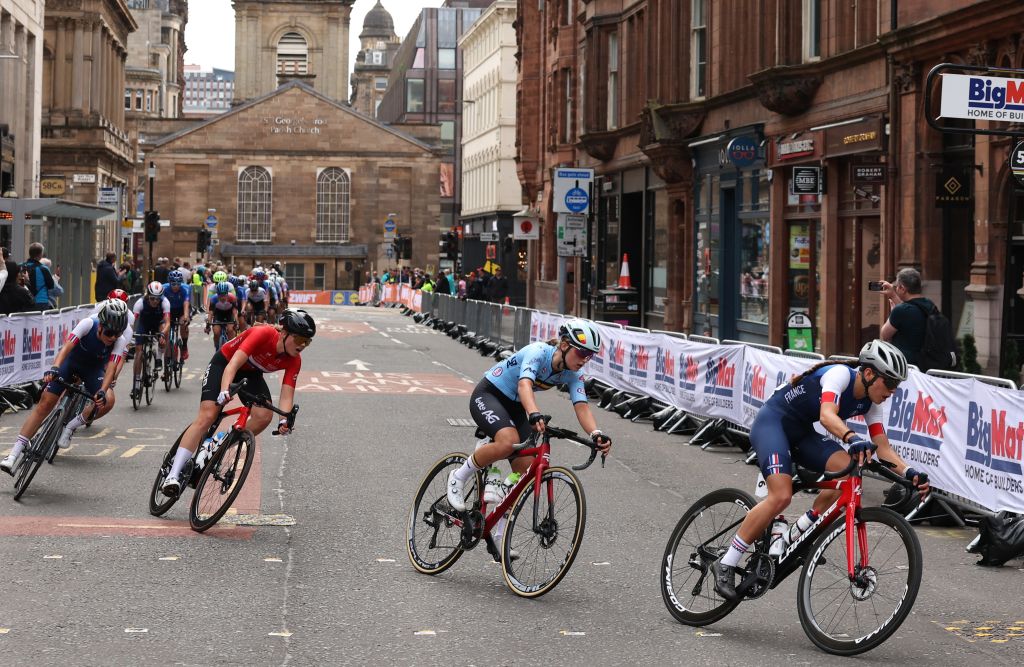
The UCI Road World Championships opened on Saturday with the road races for junior men and women, with a pair of solo winners – France's Julie Bego and Denmark's Albert Philipsen – taking the first rainbow jerseys on the road in Glasgow.
With the two races being for riders aged under 18, the shorter distances meant that they wouldn't tackle the 120km stretch from Edinburgh to the Glasgow circuit. However, there were plenty of indicators of how the elite men's race might play out.
Cyclingnews was on site to see the 14.3km city circuit in Glasgow and what types of tactics, mishaps and mayhem might be seen on Sunday.
Turn, turn, turn
There are 43 turns on the 14.3km circuit – a huge number for any road race and more akin to an American criterium than a usual Road World Championships course. That number doesn't count several chicanes and bends, and many turns are on descents.
Turns and large pelotons are not good friends and the fact the UCI has allowed the Glasgow organisers to use barricades with feet that protrude into the road rather than flat-footed apparatus will only compound the problems – especially where the course is very narrow.
In the junior women's race, there were several crashes, while in the junior men's it was hard to count how many riders went down. The race might be one of attrition but crashes will inevitably be a major factor in the outcome.
Look for riders to fly on Crow Road
After watching the junior races, the teams of the elite men will undoubtedly have concluded that there is very little benefit to keeping the race together. Shattering the peloton and taking chances from a smaller lead group seems to be the much better option.
There are very few climbs on the circuit that are tough enough to dislodge the Classics riders – even after 10 laps the much-discussed ascent of Montrose Street won't trouble any serious WorldTour sprinters. Teams can use the Crow Road climb to get rid of some of the bigger riders. It's 5.6km long and the current Strava segment record is 11:24 – owned by Michael Storer (who unfortunately didn't make Australia's team for Worlds).
Although Crow Road averages only 4.8%, the climb has about 500 metres of very steep grades midway through the climb.
There are 20.4km for riders to chase back on if the peloton splits on the climb, but a concerted effort from some key teams could do it, or it may just see a sneaky move of opportunists go clear if there are enough motivated riders – think Ben Healy (Ireland), Derek Gee (Canada), Toms Skujinš (Latvia), or maybe even former world champion Michał Kwiatkowski (Poland).
Riders who don't have teams which can control the chaotic circuits should try to make a move there.
Attacks can come anywhere
As demonstrated in the junior women's race there are more opportunities to get away than just the much-discussed Montrose Street climb. Although steep, that climb is just 200 metres long. Ellen van Dijk has one of the fastest times set on this segment, just 20 seconds.
The junior men's world champion Albert Philipsen was strong enough to ditch his breakaway companions on Montrose Street and gain enough of a lead to have plenty of time to celebrate.
If a rider like Mathieu van der Poel goes on this climb, he might have a chance but it's also possible that a surprise attack will win the day, as happened in the junior women's race when Julie Bego attacked on the short Eldon Street ascent on the back side of the course.
Because there are so many turns, and because teams aren't allowed to use race radios, knowing what exactly is going on is quite difficult. An attack could go clear on any section and there isn't a straightaway long enough to see them up ahead.
As Van der Poel stated following his preview ride, being attentive and following the correct move is going to be key on Sunday.
Can't catch back from crash/mechanical
Because the course is so full of turns, it's challenging to keep the support vehicles close enough to all the riders in case of a mechanical or mishap – there are a lot of national squads represented in the peloton, after all. At the junior women's race around the Glasgow circuit, we saw that the leader was close to catching the rear of the support car train from the group at the back of the race.
The preponderance of turns and climbs means that there are set to be few places for cars to stop and hand a rider a new bike or wheel. That means that coming back from a puncture will be very difficult, in particular the closing laps.
Again, riders are supported by their national teams rather than the trade teams they race with year-round, so the staff may not be as well-versed at quick swaps as you might see in a race like the Tour de France or one of the other major WorldTour races on the calendar like the Spring Classics.







